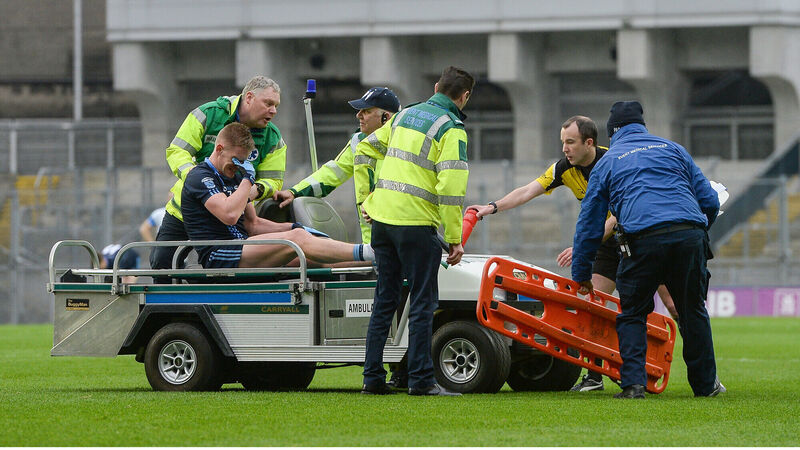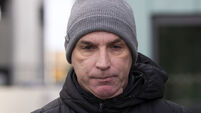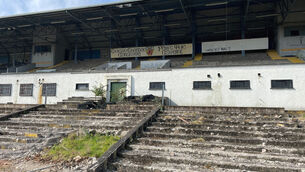Eimear Ryan: There is something about injury that makes you feel estranged from yourself

Kevin Keane of St. Patrick's Westport is helped off the field on a stretcher after picking up an injury in the first half during the AIB GAA Football All-Ireland Intermediate club championship final in 2017. 'Anyone who has done a programme of rehab exercises knows that they are tedious,' writes Eimear Ryan
In July, a week before the first championship match of the season, I sustained a partial tear to the anterior fibres of the ACL on my right knee. We were in the midst of a tough Friday night training session: hot sun, hard ground, plenty of sprints. My knee felt sore when I decelerated out of the sprints and turned to jog back to the endline, but it was only when I was walking off the pitch afterwards that I started to worry.
My leg felt heavy — dead weight, like I was dragging it around the place.
Even worse, this was the good knee. I am in my mid-thirties now and joints — and the reliability of same — are suddenly on the agenda and up for debate. I had torn the medial ligament on my left knee two years previously, and that incident was more of a classic knee-injury scenario: a sharp turn, a faint clunking sound, dramatic swelling.
I knew straightaway that I had done something to it, and had to sit out the rest of the season before getting surgery that winter. It’s basically fine now, but its two faint half-moon scars will forever mark it out as the dodgy knee.
This new injury wasn’t as bad as all that, but the psychological impact of it — and the unfortunate timing — hit me hard. If the good knee could be compromised, what was next to go? An ankle? A hip? An entire limb?
I got injured at what would normally be the height of summer hurling season, but in this topsy-turvy year, we’d only been back training five weeks at that stage. I’m sure my story was a common one, up and down the country. Club players, having missed out on those first crucial months of training, tried to make up for lost time and hit the ground running. On hard pitches, without having done the usual preparation, these things happen.
I began the work of trying to salvage my own season. I went to my GP, to physios, to a consultant, and for an MRI scan, always with the same questions: When can I go back?
When will I be right?
I’ve discovered that there’s a fundamental disconnect between injured players and the medical professionals who look after them. The consultant or the physio is thinking about what the knee will be like when the player is 60. Will it be functional? Will it be a source of chronic pain? Will it need to be replaced? Meanwhile, the player wants to know if they can play championship next weekend. In a lot of ways, you’re talking at cross purposes, having entirely different conversations.
As inevitably happens when you seek several opinions, I sometimes got conflicting advice. One physio advised against strapping the injury or using a knee support, telling me it only helped mentally, not physically. My GP looked bemused when I repeated this opinion back to her. ‘Try it, and see if it helps,’ she said. And it did help — mentally or physically or both, I can’t be sure.
Luckily, I didn’t need surgery; the tear would scar up and heal by itself with time. My physio gave me a programme and I got to work. Anyone who has done a programme of rehab exercises knows that they are tedious, but that’s what Netflix is for.
Over the course of the summer, I squatted and lunged my way through all three seasons of NBC’s . In retrospect, I could have picked a less gruesome show to watch while trying to build up my knee, but maybe on some level I needed something visceral. Something involving body horror.
Obviously, the world of sports injuries and the world of cannibalistic serial killers are miles apart. But there is something about injury that makes you feel estranged from yourself, that causes a commotion on some primal level.
The world has to be negotiated differently now; you can no longer do the things you took for granted before. Like making a cup of tea in someone else’s kitchen, you have to stop and think about each step instead of doing it automatically.
The liminal nature of injury, too, is frustrating. You feel neither here nor there — involved still, but unable to contribute in your usual way. There’s no greater sense of FOMO than standing on the sideline in your tracksuit while your teammates train. Just as sport can make you feel invincible, it can also make you keenly aware of your own frailties and limitations.
If you play sport for long enough, it seems, injury will come to you sooner or later.
Sometimes it’s sooner: Cork and Inniscarra’s Niamh McCarthy, at only 24, has torn her cruciate three times — the first time at the tender age of 14, and most recently this summer. Ireland’s Rianna Jarrett, currently playing her club soccer with Brighton & Hove Albion, has similarly torn her ACL three times — twice on the right and once on the left — and she’s only 26.
In July, Limerick’s Shane Dowling bowed out of intercounty hurling at the age of 27, also with knee trouble. Tipp’s Bonner Maher missed the business end of championship last year with an ACL injury at age 29. The list goes on, to the point where I feel I can’t really complain.
It’s hard to argue with injury in your thirties — you have accumulated years of wear and tear at that stage — but to struggle in your teens or your twenties feels unjust.
Nevertheless, there are lessons in injury. You learn the parts of yourself that require more work and support. You learn that even if you can’t play, there are other ways to contribute to your squad. You learn patience.
Most importantly, you learn that Mads Mikkelsen makes an even better Hannibal Lecter than Anthony Hopkins. I know it sounds like sacrilege, but it’s the truth.







